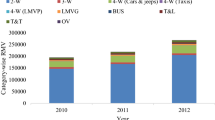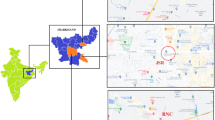Abstract
This study presents a GIS-based on-road vehicular emission inventory from the tailpipe, brake wear, tire wear and road dust resuspension due to vehicles plying on the road in the city of Lucknow. From the tailpipe, carbon monoxide (CO), sulphur dioxide (SO2), Particulate Matter (PM), oxides of Nitrogen (NOx), 1,3 Butadiene, Total aldehyde and Total PAH emissions were estimated. From the non-exhaust (brake wear and tire wear) and road dust resuspension PM10, PM2.5, and heavy metals were estimated. PM, SO2, NOx, and CO, emissions from the tailpipe are estimated to be 5.8, 0.2, 58, and 141 tons/day respectively. 1,3 Butadiene, Formaldehyde, Acetaldehyde, Total aldehyde, and Total PAH emission are estimated to be 575, 853, 113, 1468, and 57,542 gm/day respectively. PM10 and PM2.5 emission from road dust resuspension in Lucknow city was estimated to be 155 tons/day and 37 tons/day respectively. The results show that PM10 emission from road dust resuspension is 27 times higher as compared to tailpipe emission. This indicates inadequate road conditions or high silt loads in the city of Lucknow. Priority should be given to reducing silt load on roads while developing a PM mitigation plan or policy for air pollution control.












Similar content being viewed by others
Availability of data and materials
The datasets used and/or analysed during the current study are available from the corresponding author on reasonable request.
References
Amnuaylojaroen, T., Macatangay, R. C., & Khodmanee, S. (2019). Modeling the effect of VOCs from biomass burning emissions on ozone pollution in upper Southeast Asia. Heliyon, 5(10), e02661. https://doi.org/10.1016/j.heliyon.2019.e02661
Auto Fuel Policy (2002). Ministry of petroleum & natural gas, Government of India, New Delhi.
Bhaskar, V. S., & Sharma, M. (2008). Assessment of fugitive road dust emissions in Kanpur, India: A note. Transportation Research Part D, 13, 400–403.
Bose, R. K. (1999). Towards better urban transport planning–problems and policies: Case of Delhi, workshop on—Challenges for concerted action between Asia and Europe in Urban Transport, Centre for Renewable Energy Resources, the Greek National Centre for Renewable Sources. Greece.
California Air Resources Board (1998). Allergens in paved road dust and airborne particles, research Division, Air Resources Board, USEPA, Contract no. 95-312.
Candis, C., Arundhati, M., Glenn, A., Lee, B., Gene, A., Ravi, K., Brain, L., & Hal, W. (1995). Evaluation of PM10 emission rate from paved and unpaved roads using tracer techniques. Atmospheric Environment, 29, 1075–1089.
Central Pollution Control Board (CPCB) annual report. (2011). Air quality monitoring, emission inventory and source apportionment study for Indian cities (pp. 46–67). http://164.100.107.13/upload/AnnualReports/AnnualReport_34_Annual-Report-06-07.pdf. Accessed 1–8 Dec 2022.
CSIR-Indian Institute of Toxicology Research (CSIR-IITR), Lucknow (2022). Assessment of ambient air quality of Lucknow city. http://iitrindia.org/En/environmental_status_reports.aspx. Accessed 1–8 Dec 2022.
Das, A., & Parikh, J. (2004). Transport scenarios in two metropolitan cities in India: Delhi and Mumbai. Energy Conversion and Management, 45, 2603–2625.
Dey, S., Caulfield, B., & Ghosh, B. (2019). Modelling uncertainty of vehicular emissions inventory: A case study of Ireland. Journal of Cleaner Production, 213, 1115–1126.
Ganji, S. S., Ahangar, A. N., & Bandari, S. J. (2022). Evaluation of vehicular emissions reduction strategies using a novel hybrid method integrating BWM, Q methodology and ER approach. Environment, Development and Sustainability, 24, 11576–11614. https://doi.org/10.1007/s10668-021-01912-0
Goyal, P., Mishra, D., & Kumar, A. (2013). Vehicular emission inventory of criteria pollutants in Delhi. Springer plus, 216, 1–11.
Gurjar, B. R., Van Ardenne, J. A., Lelievelda, J., & Mohan, M. (2004). Emission estimates and trends (1990–2000) for megacity Delhi and implications. Atmospheric Environment, 38, 5663–5681.
Jiang, P., Zhong, X., & Li, L. (2020). On-road vehicle emission inventory and its spatio-temporal variations in North China Plain. Environmental Pollution, 267, 115639.
Kumar, R., Mishra, R. K., Chandra, S., & Hussain, A. (2021). Evaluation of urban transport-environment sustainable indicators during Odd-Even scheme in India. Environment, Development and Sustainability, 23, 17240–17262. https://doi.org/10.1007/s10668-021-01353-9
Li, R., Hua, P., Zhang, J., & Krebs, P. (2020). Characterizing and predicting the impact of vehicular emissions on the transport and fate of polycyclic aromatic hydrocarbons in environmental multimedia. Journal of Cleaner Production, 271, 122591.
Limpaseni, W. (2001). Control of road dust, regional workshop on fighting urban air pollution: from plan to action. United Nations Conference Centre, Bangkok, Thailand.
Liu, Y. H., Liao, W. Y., Lin, X. F., Li, L., & Zeng, X. (2017). Assessment of Co-benefits of vehicle emission reduction measures for 2015–2020 in the Pearl River Delta region, China. Environmental Pollution, 223, 62–72.
Liu, Y. H., Ma, J. L., Li, L., Lin, X. F., Xu, W. J., & Ding, H. (2018). A high temporal-spatial vehicle emission inventory based on detailed hourly traffic data in a medium-sized city of China. Environmental Pollution, 236, 324–333.
Marinello, S., Lolli, F., & Gamberini, R. (2020). Roadway tunnels: A critical review of air pollutant concentrations and vehicular emissions. Transportation Research Part d: Transport and Environ, 86, 102478.
Markandeya, S. S. P., & Kisku, G. C. (2016). A clean technology for future prospective: emission modeling of gas based power plant. Open Journal of Air Pollution, 5, 144–159.
Markandeya, V. P. K., Mishra, V., Singh, N. K., Shukla, S. P., & Mohan, D. (2021). Spatio-temporal assessment of ambient air quality, their health effects and improvement during COVID-19 lockdown in one of the most polluted city of India. Environmental Science and Pollution Research, 28, 10536–10551.
Nagpure, A. S., Sharma, K., & Gurjar, B. R. (2013). Traffic induced emission estimates and trends (2000–2005) in megacity Delhi. Urban Climate, 4, 61–73.
Okedere, O. B., Elehinafe, F. B., Oyelami, S., & Ayeni, A. O. (2021). Drivers of anthropogenic air emissions in Nigeria - A review. Heliyon, 7(3), e06398. https://doi.org/10.1016/j.heliyon.2021.e06398
Patra, A. K., Gorai, A. K., Rengde, V. R., & Sharma, Y. (2021). GIS-based exposure assessment and characterization of particulate matter in a mining region in India. Environment, Development and Sustainability, 23, 9852–9874. https://doi.org/10.1007/s10668-020-01037-w
Pinto, J. A., Kumar, P., Alonso, M. F., LemkerAndreão, W., Pedruzzi, R., Espinosa, S. I., MarinhoMaciel, F., & Albuquerque, T. T. A. (2021). Coupled models using radar network database to assess vehicular emissions in current and future scenarios. Science of the Total Environment, 761, 143207.
Sindhwani, R., & Goyal, P. (2014). Assessment of traffic–generated gaseous and particulate matter emissions and trends over Delhi (2000–2010). Atmospheric Pollution Research, 5, 438–446.
Singh, D., Shukla, S. P., Sharma, M., Behera, S. N., Mohan, D., Singh, N. B., & Pandey, G. (2014). GIS-based On-road vehicular emission inventory for Lucknow, India. Journal of Hazardous, Toxic, and Radioactive Waste, 10, 1–10.
Singh, V., Biswal, A., Kesarkar, A. P., Mor, S., & Ravindra, K. (2020). High resolution vehicular PM10 emissions over megacity Delhi: Relative contributions of exhaust and non-exhaust sources. Science of the Total Environment, 699, 134273.
UNEP (United Nations Environment Programme). (1999). Environmental Impacts of Trade Liberalization and Policies for Sustainable Management of Natural Resources: A Case Study on India’s Automobile Sector, New York, United Nations.
US Environmental Protection Agency. (1985a). Size Specific Total Particulate Emission Factors for Mobile Sources. EPA-460/3-85-005, US EPA, Office of Research and development, Washington, DC.
US Environmental Protection Agency. (1985b). Compilation of air pollutant emission factors, Volume 2: Stationary Point and Area Sources. US EPA, Office of Research and development, Washington, DC.
US Environmental Protection Agency. (2001). Paved road dust emissions, AP 42, Emission Factors guide series, Office of Research and Planning, USEPA Technology Transfer Network, Office of Air quality Planning, Washington, DC.
US Environmental Protection Agency. (2007). Method 3051 A, Microwave Assisted Digestion of Sediments, Sludges, Soils and Oils, Office of Research and Planning, USEPA Technology Transfer Network, Office of Air quality Planning, Washington, DC.
U.S. Environmental Protection Agency. (2011). Method to Quantify Road Dust Particulate Matter Emissions (PM and/or PM ) from Vehicular Travel on Paved and Unpaved Roads. USEPA Technology Transfer Network, Office of Air quality Planning, Washington, DC.
Venkatram, K., Fitz, D., Bumiller, K., Du, S., Boeck, M., & Ganguly, C. (1999). Using a dispersion model to estimate emission rates of particulate matter from paved roads. Atmospheric Environment, 33, 1093–1102.
Zhang, J., Peng, J., Song, C., Ma, C., Men, Z., Wu, J., Wu, L., Wang, T., Zhang, X., Tao, S., Gao, S., Hopke, P. K., & Mao, H. (2020). Vehicular non-exhaust particulate emissions in Chinese megacities: Source profiles, real-world emission factors, and inventories. Environmental Pollution, 266(2), 115268.
Acknowledgements
All the authors are highly grateful to the Director, IIT Kanpur for providing necessary facilities for this research.
Funding
No funding support.
Author information
Authors and Affiliations
Contributions
The main investigator was DS, who designed the manuscript. The technical drafting of the manuscript was done by SS, while Markandeya helped in writing. Moreover, SPS was advisor of the present research.
Corresponding author
Ethics declarations
Conflict of interest
The authors declare that they have no competing interests.
Ethical approval
Not applicable.
Consent to participate
Not applicable.
Consent for publication
All the authors have read and approved the manuscript.
Additional information
Publisher's Note
Springer Nature remains neutral with regard to jurisdictional claims in published maps and institutional affiliations.
Rights and permissions
Springer Nature or its licensor (e.g. a society or other partner) holds exclusive rights to this article under a publishing agreement with the author(s) or other rightsholder(s); author self-archiving of the accepted manuscript version of this article is solely governed by the terms of such publishing agreement and applicable law.
About this article
Cite this article
Prasad Shukla, S., Sageer, S., Singh, D. et al. A GIS based vehicular emission inventory including fugitive dust emissions of Lucknow city, India. Environ Dev Sustain (2023). https://doi.org/10.1007/s10668-023-03704-0
Received:
Accepted:
Published:
DOI: https://doi.org/10.1007/s10668-023-03704-0




